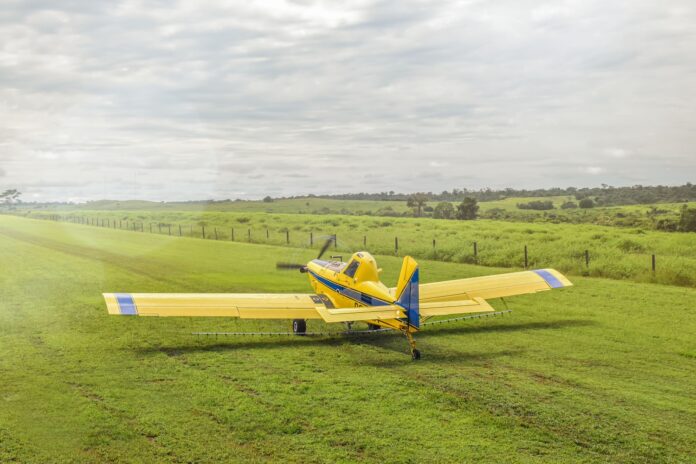I find one of the great things about aviation is that there is always something new to learn. That has the overall effect of keeping us humble if we are in the listening mood, enroute to becoming better and safer pilots. The following is one example of dealing with a steep learning curve.
I was flying a Thrush S2R from a farmer’s 2800 foot dirt strip, and the groundcrew accidentally overfilled the hopper from its normal working load of 360 gallons to a full 400 gallons. I had never flown the Thrush with a maximum load, but rather than taking the time and effort using buckets to decrease the load, I decided the aircraft could handle the extra weight.
I taxied to the opposite end of the strip from the loading station to takeoff into wind, and I clearly remember during that taxi debating the wisdom of attempting what would be slightly heavier takeoff than before. Surely the extra 40 gallons wouldn’t be that much of a factor?
Early in the takeoff run it was obvious that the aircraft acceleration was sluggish. Trundling down the runway that seemed just a bit shorter than an hour ago, wishing I had an afterburner for just a few seconds to get this beast airborne, my inner voice kept harping “Are you sure there’s enough runway?”. We had flown at least a dozen trips already that day, and I was thinking one more shouldn’t be a problem, even though we were just 40 gallons heavier.
I also clearly recall the aircraft feeling like a lead sled, with the tail coming up well past the normal spot where I had planted a red flag as a reference point for ‘tail up’. I finally did get airborne just short of the loading area but was headed towards a row of high trees off the departure end.
Luckily my left hand was leaving nothing to chance and while I was in panic mode, it opened the hopper gate and out came 400 gallons of fungicide, allowing me to soar to victory over the aforementioned trees. That was an expensive but highly educational experience.
After a terse “Whew! That was close!” moment I did a quick circuit and landing, picked up a normal load, and off to the next field on the work order. After the final trip that day I had time to reexamine the day’s work, and in particular, to spend a bit of time researching why that one specific takeoff really had my attention. I mean, it was only 40 gallons!
Part of that research involved reviewing the few times I’ve witnessed other pilots’ takeoffs where things didn’t turn out right. A Brave flipping rudder over prop and coming to a stop on its’ back. An AgCat aborting a takeoff with a resultant brake fire. A Dromader that slammed into rising terrain at the end of the strip. All had experienced pilots at the helm. Thank goodness there were no serious injuries.
One common factor was that all the aircraft had taken on slightly larger than normal loads, much as in my flight, and the pilots in each event were sure they could do the trip safely, in spite of the minor overload.
The Takeoff Equation
The following equation developed by aerodynamicists calculates the distance required for takeoff. It incorporates rolling resistance, coefficient of friction, overall weight, and various other factors.
It is also far beyond my understanding but illustrates how complex an apparently ‘simple’ task like a takeoff can be.
A Stubborn Beast
The first question was how could a small increase in load have such a pronounced effect on takeoff? The second question was how could four experienced pilots have been unaware of that pronounced effect?
Let’s start with the inertia of a parked airplane we’re trying to move by hand. No problem when empty but try to move the same aircraft with a full load. I’m sure the powerplants feel the aircraft’s same reluctance to get up and go. It’s like pulling on a donkey’s bridle trying to get the stubborn animal to move.
In my case, what difference could 40 gallons (339 lbs) make? That’s only a 4% increase given a gross weight of 8,000 lbs.
Using the rule of thumb that increasing aircraft weight by 10% increases takeoff distance by 20%, a 4% increase in weight would increase takeoff roll by 8%. We were using about 2500 feet for the usual takeoff roll on the strip, so that would mean adding 8% or 200 feet to the normal takeoff distance. That’s 2700 feet on a 2800 foot runway. Not a lot of margin to spare.
The fun doesn’t stop there. Because of extra weight the tires are squashed a bit more than normal, adding yet more drag during takeoff. It’s hard to quantify but think of what it feels like in a car when you have a partially deflated tire on one side with a resultant very noticeable pull to that side.
There was also more drag from the dirt strip as the mains sunk in just a bit more than usual given the extra weight. And more weight meant a higher airspeed to get airborne with less acceleration enroute to that number, which meant an even longer takeoff distance.
In the end, the answer to why small increases in load can greatly affect takeoff performance is a sum of a number of factors that have their root cause in additional weight: increased inertia, increased drag, increased power required. The larger the load, the more critical additional weight becomes.
It’s analogous to a person doing bench presses in the gym. When starting it’s easy to add ten pound increments to the bar, but the greater the total weight, the more difficult it becomes to lift, with the added increments getting smaller and smaller. Finally, you can’t add even one more pound and still be able to lift the bar. Power available finally equals power required.
So, if you get caught with a larger than normal load, even if it’s marginally larger and takes you into unknown territory, take a good look at the situation. Are you sure it’s safe? If not 100% sure, take the time to unload the extra product. Like many instances in aviation, being sure is not an option, it’s a mandate.





